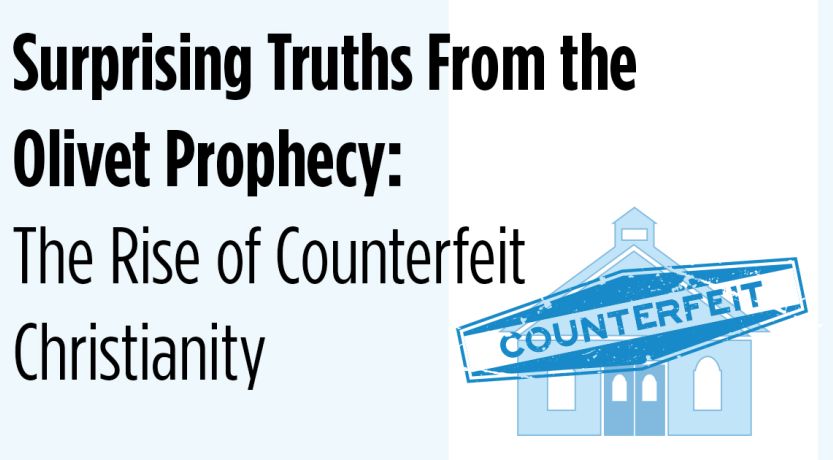In the Olivet Prophecy, Jesus Christ warned of many trends that would intensify in the end times. One was the growing influence of counterfeit Christianity.
Our last article introduced the background of Jesus’ longest recorded prophecy. The disciples had asked Him what signs would indicate His second coming was near (Matthew 24:3). His answer was what we call the Olivet Prophecy.
Jesus began with a warning that transitioned into a prophecy: “Take heed that no one deceives you. For many will come in My name, saying, ‘I am the Christ,’ and will deceive many” (verses 4-5). Luke records an additional detail of what Jesus said: “Do not go after them” (Luke 21:8).
False teachers to come in Jesus’ name
So, prior to His return, there will be an escalation of false religious teachers. But notice Jesus didn’t describe them as being openly atheist, pagan or some other form of religion that is very obviously anti-Christian. His warning was about religious leaders and ideas that appear very much Christian.
They come in Jesus’ name. They say Jesus is the Christ.
The biggest end-time religious threat will not be presented in the name of Satan or Buddha or Muhammad or Brahma or any strange false god—He said it would be presented in the name of Jesus Christ Himself.
In other words, Jesus warned that the most dangerous religion in the end time will be Christianity itself. That is, a Christianity presenting itself under the banner of Jesus—but teaching things contrary to what He taught. Its teachings will be subtle and attractive, because He says they will “deceive many” (Matthew 24:5, 11).
This is a trend that will intensify in the end times, but that had its roots going back to the first century. False versions of Christianity actually began forming in the times of the apostles, coalesced and organized after their deaths, and exist in many forms today. Many Christian churches today teach things that “deceive many,” so we write this “Christ vs. Christianity” column to help our readers sort through these untrue teachings and compare them to what Jesus and the Bible actually taught.
The apostles repeated the warning
The apostles saw the beginnings of the fulfillment of Christ’s prophetic warning. Men like Peter, Paul and John saw different ideas creeping into Christianity—ideas that were diametrically opposite to what they had learned at the feet of Jesus Himself. Let’s look at some of their warnings.
Peter: In Peter’s second epistle, likely written in the 60s, he dedicated a large amount of his letter to warning Christians of false teachers who could lead them astray. He warned that they would exploit with “deceptive words” (2 Peter 2:3), but would live lives contrary to real Christianity (verses 10-17).
One of his more specific warnings was that many of these false Christian teachers were taking the apostle Paul’s writings and twisting them to say things that contradicted what Paul (and Christ Himself) actually taught (2 Peter 3:15-16). It should be no surprise that much of the theology of mainstream Christianity today uses Paul’s writings to teach against the laws of God—the same laws Jesus said would never be abolished (Matthew 5:17-18).
Paul: Paul himself also wrote warnings of false teachings arising from both within and outside the congregations of the Church of God he oversaw.
One of his specific warnings is found in Galatians, where he warned that people were turning away from Christ’s true gospel to a “different gospel,” which was actually a perverted gospel that wasn’t in line with the gospel that had been “received” from Jesus Christ (Galatians 1:6-9). As we’ve covered in a past article, the gospel Jesus taught is sadly ignored by most of Christianity today.
John: In John’s first epistle he also warned of the emergence of false Christianity. In chapter 2 he wrote of “many antichrists” who “went out from us [the Church of God], but they were not of us” (verses 18-19). Many of his warnings centered on heretical beliefs about the Father and Jesus Christ (verses 22-23; 4:1-3; 5:10; 2 John 1:7-11).
Sadly, in the couple hundred years following the death of John, many false ideas about the nature of God and Jesus Christ emerged within popular Christianity. Today the nonbiblical doctrine of the Trinity is believed by nearly all denominations of mainstream Christianity.
After the end of the first century, history shows the emerging dominance of a Christianity that bore little resemblance to biblical Christianity. It maintained the name of Christ, but its teachings and practices deviated in many ways from the Christianity practiced by Jesus and the apostles.
The trend of false Christianity Jesus predicted in the Olivet Prophecy exists today, but it will strengthen and become even more influential, dominant and deceptive in the end times.
To learn more about the difference between the popular Christianity of today and the true Christianity of the Bible, download our free booklet Where Is the Church Jesus Built?
You can find the previous article in this series at “Surprising Truths About the Olivet Prophecy, Part 1.” See the next article in the series at “Part 3: Lawlessness Will Abound.”
Sidebar: The 3 Types of Prophecies in the Olivet Prophecy
In order to understand the Olivet Prophecy, it’s important to consider that Jesus gave three different types of prophecy in this message.
- The first type is trends. These are general societal characteristics we will see in the world prior to Jesus’ return. These characteristics are not totally unique to the end time, but will seriously intensify to dangerous levels before Jesus’ return. An example would be Jesus’ prophecy about pestilence in the end times (Matthew 24:7). Devastating plagues have occurred throughout history, but there will be disease epidemics of unimaginable proportion in the end time.
- The second type is specific events. These are explicit events Jesus predicted that will have a future fulfillment at a specific time. An example of this would be the prophecy about the “abomination of desolation” (verse 15). That is a future event.
- The third type is prophetic warnings. These are spiritual warnings to God’s people who will be living at the time when these prophecies are fulfilled. An example of this is Christ’s warning to be ready and prepared for Christ’s return (verse 44).






